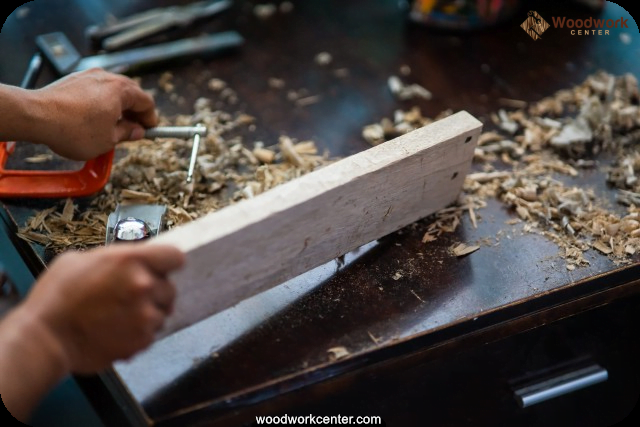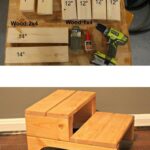Woodworking jigs are an essential tool for any woodworker, whether they are a seasoned professional or just starting out. In this article, we will explore the world of woodworking jigs and their many uses. From their benefits to different types and how to make your own at home, we will cover it all. If you’ve ever wondered what woodworking jigs are used for, read on to discover the answer and much more.
Woodworking jigs are devices that help woodworkers perform tasks with precision and ease. They can be used to guide cutting tools, hold workpieces in place, or ensure accurate measurements. Essentially, they are designed to simplify complex woodworking processes and improve the overall quality of the final product.
Using woodworking jigs in your projects comes with a plethora of benefits. Not only do they save time and effort, but they also enhance accuracy and repeatability.
Whether you’re working on a simple DIY project or a more complex piece of furniture, woodworking jigs can greatly improve the outcome while minimizing the margin for error. In the following sections, we will delve into different types of woodworking jigs, how to make them at home, tips for safe usage, and examples of common jig setups and applications.
The Benefits of Using Woodworking Jigs in Your Projects
Woodworking jigs are an essential tool for any woodworker, whether they are a beginner or an experienced professional. These handy devices are used to guide cutting tools, hold workpieces in place, and ensure precision and accuracy in woodworking projects. The benefits of using woodworking jigs in your projects are numerous and can significantly enhance the quality of your work.
One of the main advantages of using woodworking jigs is the ability to achieve consistent and precise results. Jigs help to eliminate human error by providing a template or guide for making accurate cuts, holes, or other necessary actions. This consistency is crucial for ensuring that all pieces fit together seamlessly in the final product.
In addition to precision, woodworking jigs also offer increased safety during the cutting and shaping process. By securely holding the workpiece in place, jigs reduce the risk of kickback or movement that could lead to accidents. This is especially important when working with power tools such as routers or saws. Woodworking jigs provide stability and control, allowing woodworkers to focus on the task at hand without worrying about potential hazards.
Another benefit of using woodworking jigs is the time savings they offer. Once a jig is set up and calibrated, it can be used repeatedly to produce identical cuts or shapes without the need for measuring and marking each individual piece. This streamlines the production process and allows woodworkers to work more efficiently, ultimately increasing productivity.
| Advantages | Description |
|---|---|
| Precision | Jigs help eliminate human error and ensure consistent results |
| Safety | Jigs securely hold workpieces in place, reducing the risk of accidents during cutting and shaping |
| Time Savings | Once set up, jigs can be used repeatedly for identical cuts or shapes, saving time and increasing productivity |
Different Types of Woodworking Jigs and Their Uses
Woodworking jigs come in various types, each with its specific use and function. These tools are designed to assist woodworkers in completing their projects more efficiently and accurately. Here are some of the different types of woodworking jigs and how they are used:
1. Doweling Jig: This type of jig is used to create accurate and consistent dowel holes in wood pieces for joinery purposes. The jig typically clamps onto the workpiece, guiding the drill bit to ensure precise hole placement.
2. Box Joint Jig: Box joint jigs are designed to help woodworkers create strong and aesthetically pleasing box joints or finger joints. These jigs can be used with a table saw or a router table to produce evenly spaced fingers or pins for joining two pieces of wood together.
3. Dovetail Jig: Dovetail joints are known for their strength and decorative appeal. A dovetail jig assists woodworkers in creating these joints by guiding the cutting tool to produce perfectly angled and spaced tails and pins.
4. Router Jig: A router jig is a versatile tool that can be used for various woodworking tasks, including creating dadoes, grooves, or mortises, as well as shaping edges or templates.
These are just a few examples of the many types of woodworking jigs available to woodworkers. Each type serves a specific purpose in enhancing precision and efficiency in various woodworking applications.
It’s important to note that understanding the different types of woodworking jigs and their uses allows woodworkers to choose the right jig for a particular task, ultimately improving the quality of their work while saving time and effort. With the right jig, woodworkers can achieve more consistent results and tackle complex joinery or shaping tasks with greater ease.
How to Make Your Own Woodworking Jigs at Home
Woodworking jigs are incredibly useful tools that can help enhance the precision and efficiency of your woodworking projects. While there are many types of woodworking jigs available for purchase, making your own at home can be a cost-effective and customizable option.
Materials Needed
To make your own woodworking jig at home, you will need some basic materials such as plywood or MDF for the base, screws, clamps, and the specific tools necessary for the type of jig you are creating (e.g. a router, saw, or drill).
Types of Woodworking Jigs You Can Make
There are various types of woodworking jigs that you can make at home, including those for cutting angles, drilling straight holes, routing dadoes and grooves, and more. The specific type of jig you decide to make will depend on the needs of your particular woodworking project.
Steps to Create Your Own Woodworking Jig
The process of making a woodworking jig at home typically involves measuring and cutting the base material, assembling any necessary guides or stops, and ensuring that the jig is securely attached or clamped to the workpiece. Additionally, it’s important to test the accuracy and functionality of your homemade jig before using it on your actual woodworking project.
By following these steps carefully and paying attention to detail, you can create a custom woodworking jig that meets your specific project requirements.
Creating your own woodworking jigs at home allows you to tailor them to your unique project needs while also saving costs on purchasing pre-made jigs. With some basic materials and tools, along with careful planning and execution, you can create effective jigs that streamline your woodworking process and improve the overall quality of your finished products.
Tips and Tricks for Using Woodworking Jigs Safely and Effectively
Woodworking jigs are incredibly useful tools for any woodworker, allowing for precision and consistency in their projects. However, using woodworking jigs safely and effectively is crucial to maximize their benefits. Whether you are a beginner or an experienced woodworker, following these tips and tricks can help you make the most out of your woodworking jigs.
Proper Setup and Alignment
One of the most important aspects of using woodworking jigs is ensuring that they are properly set up and aligned with the workpiece. This involves meticulously measuring and marking the locations for the jig, as well as securing it in place to prevent any movement during the cutting process. Taking the time to set up and align your woodworking jig accurately will result in precise cuts and consistent results.
Understanding Material Thickness
Different woodworking jigs are designed to accommodate varying material thicknesses. It is essential to understand the capabilities of your jig and adjust it accordingly based on the thickness of the wood you are working with. Failing to do so can result in inaccurate cuts or even damage to both the jig and the workpiece.
Use Proper Safety Equipment
When using woodworking jigs, it is vital to prioritize safety by wearing appropriate protective gear, such as safety goggles, hearing protection, and dust masks. Additionally, always follow manufacturer guidelines for each specific jig to ensure safe operation. Woodworking jigs can involve power tools or sharp cutting implements, so taking safety precautions is crucial for injury prevention.
By following these tips and tricks for using woodworking jigs safely and effectively, you can enhance your woodworking skills while prioritizing your personal safety. Understanding how to properly set up and align your jigs, adjusting for material thickness, and using proper safety equipment will allow you to make precise cuts with confidence.
Examples of Common Woodworking Jig Setups and Applications
Woodworking jigs are incredibly versatile tools that can be used for a wide range of applications in woodworking projects. One common use for woodworking jigs is for creating joints, such as dovetail, box, or finger joints. These jigs help woodworkers achieve precision and consistency in their joinery work, resulting in high-quality, professional-looking finished products.
Another common application of woodworking jigs is for cutting and shaping wood. For example, a crosscut sled jig can be used with a table saw to make perfectly straight and accurate cuts every time. Similarly, templates and guides can be used to create consistent shapes and curves in woodworking projects.
In addition to joinery and cutting, woodworking jigs can also be utilized for drilling precise holes at specific angles or depths. This can be particularly useful when creating furniture or cabinetry that requires hardware installation. By using a drill press jig or doweling jig, woodworkers can ensure that all the necessary holes are drilled accurately and consistently.
Overall, woodworking jigs are indispensable tools that contribute to the precision, accuracy, and efficiency of woodworking projects. Whether you’re a beginner or an experienced woodworker, integrating jigs into your workflow can greatly enhance the quality of your craftsmanship.
| Woodworking Jig Application | Examples |
|---|---|
| Joinery | Dovetail jig, box joint jig |
| Cutting & Shaping | Crosscut sled jig, template/guide for curves |
| Drilling | Drill press jig, doweling jig |
Woodworking Jigs as a Time-Saving and Precision-Enhancing Tool
Woodworking jigs are an essential tool for any woodworker looking to save time and achieve precise results in their projects. There are various types of woodworking jigs, each designed for specific tasks and applications. Here are some common woodworking jig setups and applications:
- Dovetail Jig: This type of jig is used for creating dovetail joints, which are popular for their strength and aesthetic appeal in woodworking projects such as drawers and cabinets.
- Drill Jig: A drill jig is used to guide the placement of holes in wood, ensuring accurate and uniform hole spacing for things like shelves or hardware installation.
- Crosscut Sled: This jig is used with a table saw to make crosscuts with precision, safety, and repeatability. It can be adjusted to different angles and lengths, making it versatile for various projects.
Using woodworking jigs not only saves time by streamlining the process of creating intricate joinery or making precise cuts, but it also enhances the overall precision of your work. Whether you’re a seasoned professional or a beginner woodworker, incorporating jigs into your workflow can elevate the quality and consistency of your projects.
In addition to time-saving benefits, woodworking jigs also contribute to the safety of your workshop. By providing stability and guidance during cutting or drilling processes, jigs reduce the risk of accidents or mistakes that may occur when attempting these tasks freehand. Overall, woodworking jigs serve as a valuable tool for woodworkers looking to achieve professional-level results in their craft.
Conclusion
In conclusion, woodworking jigs are an essential tool for any woodworker looking to enhance their skills and productivity. Whether you are a beginner or an experienced craftsman, using woodworking jigs can greatly improve the precision of your cuts, increase efficiency, and minimize the risk of error. By taking advantage of different types of woodworking jigs and understanding their uses, woodworkers can tackle a wide variety of projects with greater ease and confidence.
One of the main benefits of using woodworking jigs is the ability to achieve consistent and accurate results. This is particularly important when working on complex or detailed pieces where precision is key. Additionally, by making your own woodworking jigs at home, you can customize them to suit your specific needs and save money in the process. With proper safety precautions in place, woodworking jigs can also help minimize the risk of accidents and injuries while working with power tools.
Overall, woodworking jigs serve as a time-saving and precision-enhancing tool that can take your projects to the next level. By incorporating different types of woodworking jigs into your workflow and mastering their use through practice and experience, you can elevate the quality of your work while also expanding your capabilities as a woodworker. So next time you embark on a new woodworking project, consider how incorporating various woodworking jigs can make a significant difference in the outcome.
Frequently Asked Questions
What Is a Jig Used for in Woodworking?
A jig in woodworking is a tool or fixture that guides and holds the cutting or shaping tools, ensuring precise and consistent results. It helps woodworkers create repeatable cuts, holes, or shapes.
Why Do I Need a Jig?
Woodworkers need jigs to achieve accuracy and consistency in their woodworking projects. Using a jig can improve the quality of the finished product by ensuring that cuts, holes, or shapes are identical each time they are made.
What Is the Best Wood for Woodworking Jigs?
The best wood for constructing woodworking jigs is hardwood, specifically maple or birch. These woods are strong, stable, and able to withstand the wear and tear of repeated use. Additionally, they are less likely to warp or deform over time compared to softer woods like pine or fir.

Hi everyone! I’m a woodworker and blogger, and this is my woodworking blog. In my blog, I share tips and tricks for woodworkers of all skill levels, as well as project ideas that you can try yourself.





